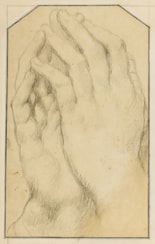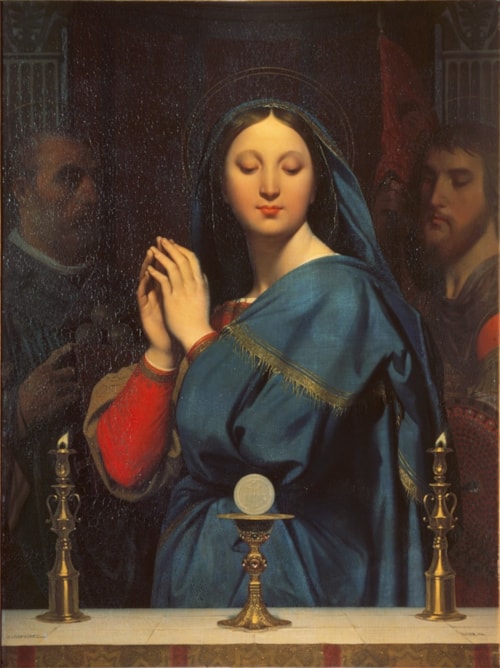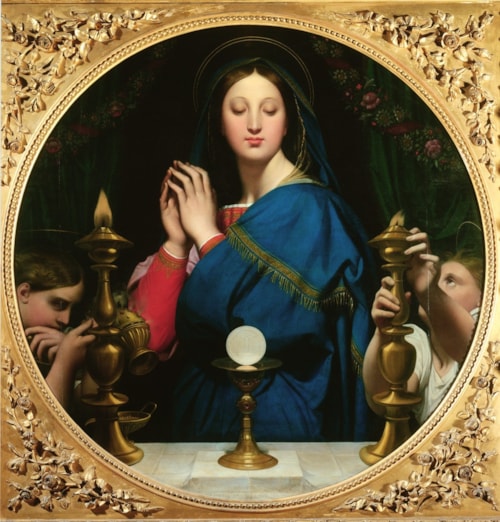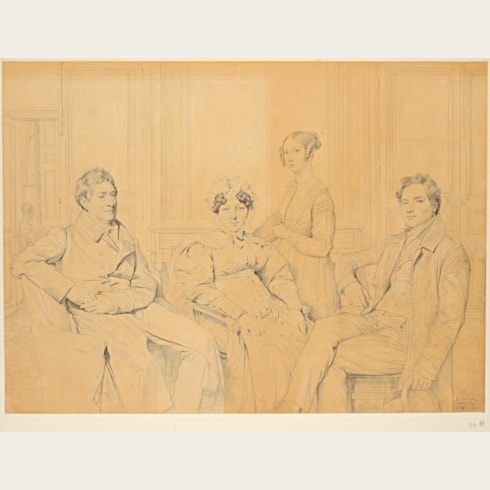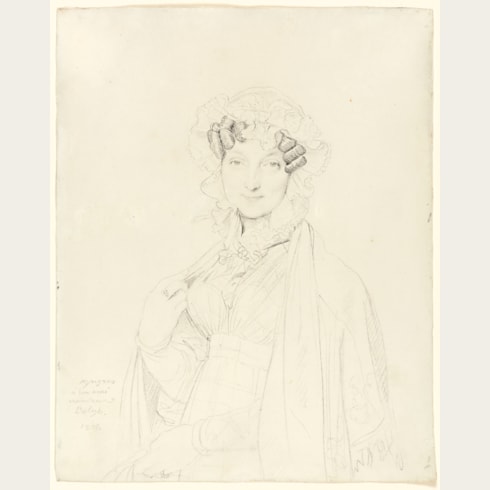Jean-Auguste-Dominique INGRES
(Montauban 1780 - Paris 1867)
Study of the Hands of the Virgin in Prayer
Sold
Pencil. A made-up section at the lower right corner.
233 x 144 mm. (9 1/8 x 5 5/8 in.)
233 x 144 mm. (9 1/8 x 5 5/8 in.)
This drawing is a study for the hands of the Virgin in Ingres’s painting of The Virgin Adoring the Host, which is known in two versions; one commissioned by the future Czar Alexander II in Rome and completed in 1841, which is today in the Pushkin Museum in Moscow, and the other, a circular composition commissioned by the State in 1851 and completed three years later, which is now in the Musée d’Orsay in Paris. Similar hands also appear in a finished watercolour version of The Virgin Adoring the Host, in the Prat collection in Paris, and in a large oil sketch of The Virgin Adoring the Christ Child in a private collection in New York, which has been dated to c.1839 and regarded as a première pensée for the Pushkin painting.
It can be noted that the hands in this drawing are close to those of the standing Virgin in a preparatory chalk study, today in the Musée Ingres in Montauban, for Ingres’s 1824 altarpiece of The Vow of Louis XIII, painted for the cathedral in Montauban. A nude figure drawing of the praying Virgin with similar hands, which has also been related to the The Vow of Louis XIII, is in the collection of the Musée d’art et d’histoire in Geneva. In the final painted version of The Vow of Louis XIII, however, the Virgin is no longer shown in prayer, but instead holds the Christ Child.
Ingres may have also used this drawing, or a similar one, between 1822 and 1827, when he painted an oval Virgin with a Blue Veil for the Marquis Amédée de Pastoret; the painting, in which the hands are likewise very close to those in this drawing, is today in the Museu de Arte de São Paulo in Brazil. A pencil tracing of the praying hands in the São Paulo painting, of similar dimensions to the present sheet, is among the very large cache of drawings by the artist in the Musée Ingres in Montauban.
The careful depiction of hands was an essential part of Ingres’s paintings, and in particular his portraits. Furthermore, as has been noted, ‘It was only natural that Ingres characterized his models so well through their hands, for he himself was often described in terms of his own.’ Apparently, when in conversation, the artist himself tended to use his hands in a most expressive manner, particularly when agitated or upset.
It can be noted that the hands in this drawing are close to those of the standing Virgin in a preparatory chalk study, today in the Musée Ingres in Montauban, for Ingres’s 1824 altarpiece of The Vow of Louis XIII, painted for the cathedral in Montauban. A nude figure drawing of the praying Virgin with similar hands, which has also been related to the The Vow of Louis XIII, is in the collection of the Musée d’art et d’histoire in Geneva. In the final painted version of The Vow of Louis XIII, however, the Virgin is no longer shown in prayer, but instead holds the Christ Child.
Ingres may have also used this drawing, or a similar one, between 1822 and 1827, when he painted an oval Virgin with a Blue Veil for the Marquis Amédée de Pastoret; the painting, in which the hands are likewise very close to those in this drawing, is today in the Museu de Arte de São Paulo in Brazil. A pencil tracing of the praying hands in the São Paulo painting, of similar dimensions to the present sheet, is among the very large cache of drawings by the artist in the Musée Ingres in Montauban.
The careful depiction of hands was an essential part of Ingres’s paintings, and in particular his portraits. Furthermore, as has been noted, ‘It was only natural that Ingres characterized his models so well through their hands, for he himself was often described in terms of his own.’ Apparently, when in conversation, the artist himself tended to use his hands in a most expressive manner, particularly when agitated or upset.
A student of Jacques-Louis David, Jean-Auguste-Dominique Ingres won the Prix de Rome in 1801, although due to a lack of government funding he was unable to take up his scholarship at the Académie de France in Rome until 1806. Although his pension expired in 1810, he remained in Rome for a further ten years. The city was at this time ruled by the French, and Ingres received commissions for paintings to decorate both the Villa Aldobrandini, the official residence of the French Lieutenant-Governor of Rome, and Napoleon’s palace at Monte Cavallo. He also found patrons among the French officials in the city, whose portraits he painted, as well as members of the royal court in Naples, led by Napoleon’s sister Caroline Murat and her husband Joachim, rulers of the Kingdom of the Two Sicilies. With the French withdrawal from Rome in March 1814 and the fall of Napoleon, however, Ingres found himself bereft of official commissions, and turned to making portrait drawings of French and foreign visitors to the city. These pencil portraits, drawn with minute detail as autonomous works of art, proved very popular and served to confirm Ingres’s reputation, allowing him to survive his difficult, penurious years in Rome.
In 1820 Ingres received a commission for a large canvas of The Vow of Louis XIII, intended for the cathedral of his native Montauban. Painted in Florence and sent to Paris to be exhibited at the Salon of 1824, it won Ingres considerable praise and established his reputation as a painter. He then spent a period of ten years in Paris, where he consolidated his reputation as a history painter and began receiving portrait commissions. This was followed in 1834 by an appointment as director of the Académie de France in Rome, Ingres remaining in the post until his final return to France in 1842. The last fifteen years of his career saw Ingres firmly established as an influential and highly respected figure in artistic circles, and one of the foremost artists in France. For many years an influential professor at the Ecole des Beaux-Arts, Ingres received the honour of a retrospective exhibition at the Exposition Universelle of 1855.


